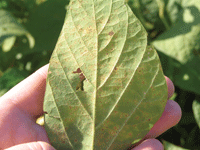An online early warning system the Agriculture Department put in place to help growers fight an infection targeting U.S. soybean crops has, by some estimates, saved farmers hundreds of millions of dollars.It also is an example of how the government quickly acted to get ahead of trouble before it struck full force.The Soybean Rust Early Warning system, at www.usda.gov/soybeanrust, instructs farmers about the best way to prevent the disease or, if it has hit, eliminate it before more damage is done. The site has information about potential outbreaks'including forecasts and geospatial data about where it could appear, tips on preventing it, and information on appropriate chemicals to eliminate the fungus.'The USDA Economic Research Service estimates that this information helped save U.S. soybean growers up to $300 million during the 2005 growing season,' said William Hoffman, National Program Leader for Agricultural Homeland Security in USDA's Cooperative State Research, Education and Extension Service.Soybean is a major U.S. commodity, and USDA pays for insured crop losses. Before migrating to the United States, soybean rust caused major crop losses in parts of Asia and South America.Providing soybean growers with timely and reliable information helped to prevent unnecessary or ill-timed pesticide applications, Hoffman said.Without the information provided by the system, growers might spray with too many chemicals for fear that the fungus might spread to their fields. Or growers might not take adequate steps to protect their fields when the risk is high, he said.USDA works with cooperative extension specialists at state universities to provide local commentary on the early warning system to encourage growers to use good farming practices, he said.Nine states have confirmed soybean rust cases. Most are in the south and southwest. Wind carries rust spores over long distances, and common invasive plants, such as kudzu, also act as a host for the fungus.Growers already have reduced damage and increased crop yields as a result of changing how they manage soybean rust because of the information on the Web site, said the Economic Research Service in its recent report evaluating the early warning system.It is important for growers to respond effectively to soybean rust because, while they can file claims for insured crop losses if the fungus causes damage, they're required to show that they followed good farming practices. USDA's Risk Management Agency makes the payments.To assure proper payments, RMA recently launched a Good Farming Practices Documentation application so farmers can record actions that they have taken to prevent or treat a soybean rust outbreak, said Heyward Baker, director of RMA's risk-management services.'We want to pay losses that are due, but we only want to pay those losses that are payable under the policy and have followed the law,' he said.The document application is voluntary. The grower can download the file in Adobe Portable Document Format and print out the form. The agency does not store the information in a database.RMA provided the standard documentation form because it found that some farmers have not compiled the right information, which the insurance company that delivers the crop insurance program needs to determine if the farmer followed proper procedures.The Web site makes recommendations to farmers for their specific geographic areas. For example, if soybean rust is found in Jackson, Miss., the state extension specialist posts the information and sends out an alert to area growers. The specialist would make a judgment as to whether growers should spray the plants with chemicals'and how much, depending on the growth stage of the plant and how much infection could be in the area.Through an agreement with the Cooperative State Research, Education and Extension Service, RMA provided $2.5 million to fund a project for 2006.ZedX Inc. of Bellefonte, Pa., designed, manages and supports the Web site, integrated platform and data management behind it, geospatial data and management tools, such as the documentation piece. ZedX is in its third year of a year-to-year contract, said Joe Russo, company president and senior scientist. The Web site has two levels, one restricted to researchers, industry specialists and government with log-on and password, the other for public view. Users see different things based on their authorizations, he said.The soybean rust system is an open-source, Linux system. Other than the open-source code and the MapServer GIS mapping applications, ZedX has written the code, Russo said.'Open source links us to a larger community of developers. It saves the government and removes any issue of licensing,' he said.Other government organizations, such as the National Weather Service, are using open source or leaning that way because of the the potential cost savings.Russo said USDA began preparing for soybean rust migration in 2003. Department teams ran simulations in the field, trained people and passed out information. ZedX began designing and developing the system in 2004 and it went live last year.'They were ahead of the curve before it came,' he said.USDA's initiative showed the value of the Web, the coordination of people using the Web and information targeted and distributed to the grower population.'The country has reached a technical level with growers that allowed this to happen. It was almost the ideal pest at the ideal time, technologically,' Russo said.The Soybean Rust Early Warning System will morph later this year into the Pest Information Platform for Extension and Education as it tests information services for additional crops and pests, including the soybean aphid, Hoffman said.
RUST NEVER SLEEPS: Soybeans are a major U.S. crop. Soybean rust has caused huge losses in other nations.
Courtesy of the Ohio State University Agricultural Research and Development Center







